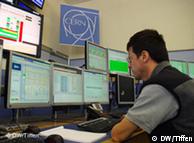The Large Hadron Collider (LHC) at the European Organization for
Nuclear Research, better known by its French acronym, CERN, has been
colliding beams since March of this year, after an abortive attempt in
September, 2008.
The LHC now has to produce as many collisions as possible in the next
two years in order for the various experiments at CERN to essentially
prove their worth among other established particle physics laboratories.
The past failures of the LHC weighed heavily on operations group
leader Mike Lamont who talked about some of the criticism from the
media.
"The Americans in particular can be quite aggressive," he told
Deutsche Welle.
"It's quite clear that we're competing with the States, and we've had
setbacks, and you can see journalists occasionally being aggressive
about that," he said. "I mean 'You're spending taxpayers' money, and
you're still messing up,' which can be a fair comment."
Raising the bar
The competitive element of the research performed at the LHC also
extends beyond mere media heckling, however, seeming to be an essential
part of CERN's research strategy.
 Bildunterschrift: Großansicht des Bildes
mit der Bildunterschrift: The
LHC staff is under pressuure to produce as many collisions as possible
Bildunterschrift: Großansicht des Bildes
mit der Bildunterschrift: The
LHC staff is under pressuure to produce as many collisions as possible
One of the lessons learned from the failed start of the LHC in 2008,
was that the machine would not be able to reach its desired energy
output of circulating 7.0 tera electron volt (TEV) beams. Instead the
scientists on the project must make the most of the current maximum of
3.5 TEV beams that collide at a combined 7.0 TEV, half of the original
goal.
Only if the experiments meet their goals for collected data by 2012,
Lamont said, would CERN pull ahead of the research performed at the
US-based Fermilab, a particle accelerator located near Chicago, Illinois
that measures 6.3 kilometers in circumference.
"We've got reach in energy, but they're still sort of chasing at our
heels," Lamont said. "So if we can collect enough data in 2010 and 2011,
we essentially put them out of business, then we can relax in 2012 and
fix the [LHC] properly."
Common goals
Not everyone at CERN is so concerned with being in first place,
however. Yves Schutz, at ALICE, one of the experiments studying the LHC
data, takes a more egalitarian position.
ALICE, which is an acronym for A Large Ion Collider Experiment, will
be studying collisions of lead ions in the LHC, looking for primordial
matter called the quark-gluon plasma, believed to have existed for a few
millionths of a second after the Big Bang.
At the Brookhaven National Laboratory in New York, the Relativistic
Heavy Ion Collider (RHIC) is pursuing a very similar course of study. In
February RHIC announced that it had found the "quark soup" after
colliding gold ions. For Schutz, this didn't constitute a threat to his
own research, so much as an opportunity to collaborate.
"We have very regular joint meetings," he said.
"RHIC is just paving the way for LHC; it's no different, just
complementary," Schutz said. "Nuclear research has always proceeded in
steps, and every step was the advent of new accelerators with higher
energies."
But Schutz couldn't resist one small barb at the smaller American
program.
"We have a good number of physicists who worked at RHIC who have
joined ALICE, but the opposite is not the case," he said with a smile.
Author: Stuart Tiffen
Editor: Mark Mattox
http://www.dw-world.de/dw/article/0,,5731475,00.html









